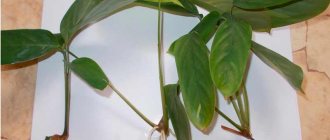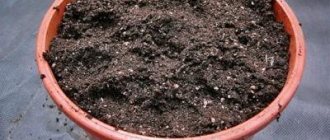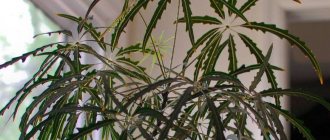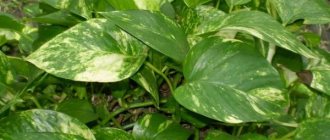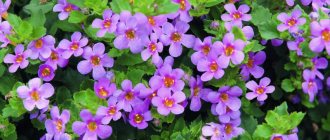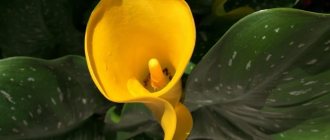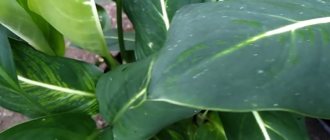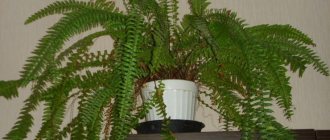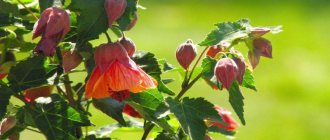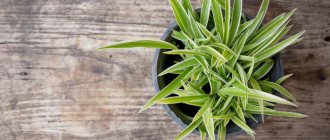Columneya is a perennial epiphytic plant with bright flowers. Homeland - tropics in the south of America. In a normal environment, Columna grows on rotten tree trunks, in stone crevices, using them as a support, forming beautiful inflorescences. The stems are elastic, juicy, reaching 1-2 meters. The leaves are densely arranged, oval or heart-shaped, sometimes oblong. The flowers come in different colors and resemble fish or butterflies.
In the house it is spectacular in flowerpots and hanging pots.
Description of the plant
Columnea is a hanging plant from the Gesneriaceae family, growing in tropical areas of America.
The stems are flexible, their length can reach 2 m. The leaves are fleshy, small, up to 4 cm long, hard, elongated-oval, located opposite on the stem.
Columna flowers can be yellow, orange, red, or less often pink
The two upper petals of the flower are connected and form the so-called hood. The fruits are white, spherical in shape.
Of the well-known domestic plants, relatives of Columna are Kaleria and Gloxinia. Columna is sometimes called the “indoor orchid”, however, they have no relationship with the orchid.
Columnea looks especially impressive in hanging pots and flowerpots.
Description of the column and its photo
To grow Columna at home, you need to know what kind of plant it is and what it looks like.
Therefore, I will try to talk about the structure of a flower in as simple a language as possible. I will also show you a photo of Columna at home and in its natural habitat. Columna is not a common plant in the wild. It grows in the warm hemisphere, namely in the tropics. In particular, these are Latin and Central America. The warm climate allows the plant to develop freely in open ground conditions. Therefore, if you look at a photo of a wild-growing columna, the difference with domesticated crops and varieties is noticeable.
The flower genus “goldfish” currently includes approximately 200 species. All of them are epiphytes. These are plants whose root system requires light nutrient soil (for example, like an orchid) or does not require it at all. Experienced gardeners grow the plant in an unusual way. One “plants” it on a block, others try to create whole bouquets of ornamental plants using a substrate for epiphytes.
Herbaceous columnea is an energetic flower with ampelous shoots and an aerial root system. It is easy to care for and easily acclimatizes at home. Don't be surprised if the shoots of a young goldfish flower grow vertically at first. This is the peculiarity of the plant. With age, the stems droop under the weight of the leaf and flower mass. Although, there are varieties with erect stems. What all types have in common is the light white edge of the shoots and their fleshiness. They can break with one touch; columnae is considered a fragile indoor flower.
The oval or heart-shaped leaves The plate is green, leathery. The surface is glossy and smooth to the touch (less often velvety due to small hairs). The leaf is large in length - up to 10 cm. If plants have small leaves (3-4 cm). The arrangement of the plates is opposite. They form a lush green mass.
Flowering begins in winter and ends in early spring. It is long-lasting and abundant if all the conditions for maintaining the home are created. The buds are axillary, formed under the leaves in the central part of the shoot. The corolla is tubular, elongated, up to 5-9 cm long. Some compare decorative varieties of columna with rare orchids. The flower is yellow, red, orange or shimmers from one shade to another.
In terms of the structure of the bud, Columnea is very similar to Koleria and Gloxinia. Indeed, these plants are close relatives. But, unlike the same color, the “goldfish” flower grows ampelously and is capable of developing as a vine.
Types of columna
The following types of columna are distinguished:
- Columnea Consanguina is a shrubby plant with a brown, hairy stem that grows up to 1.5 m. The leaves are arranged in pairs, but one leaf is always smaller than the other, so the leaves appear to be arranged alternately. The flowers are pale yellow.
- Columnia krakatoa is an epiphyte (a plant that requires support - another plant, for example). One of the most common among gardeners, it is often used to decorate a home or office. The flowers are very bright, the leaves completely cover the trunk.
- Carnival. Valued for its numerous flowers, the bright yellow petals of which have a noticeable red border. The plant is small and can bloom for a whole year.
- Columnea red is distinguished by creeping thick shoots and lanceolate leaves.
- Columnae Banks. It is unpretentious in care, so it is also widespread. The stems droop and branch heavily. The leaves are green on top and red on the underside. Flowers are up to 6 cm long, red-orange with a yellow throat.
- Glorious and small-leaved are plants with pubescent leaves. Their flowers are similar in shape and color, however, the leaves of the glorious Columna are about 8 cm, and the leaves of the small-leaved plant are only 1 cm.
- Columna thickifolia is distinguished by erect shoots.
- Columnia cusis is a hanging plant whose dark green leaves appear to be carved out of leather.
- Other types of columna are found less frequently in decorative floriculture. These are Columna vedrare, Columna Morton, Columna acute, Columna Allen.
Photo gallery: different types of columna
Red columnar has hard lanceolate leaves
Yellow and orange flowers distinguish Columna Banks
Columna gloriousa has pubescent leaves
Small leaves give the name to this type of columna
Krakatoa is often used to decorate a home or office.
Flowers are distinguished by a red border around the edge of the petals
Varieties
Small-leaved Columnaea (micriphilla) is a beautifully flowering plant with bright orange flowers blooming on its stems in the spring. From a distance, they resemble jumping goldfish, which is why flower growers call this variety among themselves - Goldfish. Under natural conditions, small-leaved columna grows only on trees, and it needs roots only for adhesion to support, and not for nutrition.
Columnaea kewensis is a hanging plant with dark green leaves that look as if they are made of leather. One of the most popular species in indoor floriculture.
Columnaea x Banksii (xbanksii) has long (up to 90 cm) drooping shoots, with large oval leaves of dark green color and large beautiful flowers: scarlet with light spots.
Table: conditions by season
| Temperature | Lighting | Humidity | |
| Spring Summer | 18–20 оС | Bright diffused sunlight. East or west windows. | Systematic spraying, more frequent in the summer heat. |
| Autumn winter | During the dormant period (begins at the end of autumn), which lasts about 50 days, it is necessary to ensure a temperature of 10–12 °C. Then the flower is moved to a warmer place. | Bright diffused sunlight. South windows. | Do not spray during the dormant period. |
Aeschynanthus and Columnaea différance
Although Columnea and Eschynanthus are representatives of the Gesneriaceae family, they have peculiar differences. Columnaea flowers have the same color. Aeschynanthus, on the other hand, has a flower bed of one color, and the corolla itself is a different color. Eschynanthus is a rather beautiful evergreen plant. It, like Columna, comes from the tropics. It has a fairly large number of species and subspecies, up to 185.
Grows as vines and shrubs. In home gardening, aeschynanthus is quite rare. This is because this flower is very picky when planted and grown at home.
But if you follow them with the greatest precision, then it can please you with its flowering. Of course, the flowering will be short-lived and not as intense as that of the columnar. But it's still worth it. It is usually grown in hanging pots.
The branches of Eschynanthus reach a length of up to 45 centimeters. The leaves are oval-oblong and fleshy, unlike columnea. Leathery, bright green and shiny, 4 to 10 centimeters long. There is this plant that looks like a bush.
There are also hybrids (these are subspecies) with variegated leaf colors. Color of Eschynanthus flowers: orange, bright red with a yellow or brown corolla. Of course, this plant is very similar to Columna. But there are still clear differences between these colors. Aeschynanthus does not reach such large sizes as columna. The flowers of Eschynanthus are also completely different. The upper petals are shorter and resemble a hood.
And in the columna, the flowers form a hood with petals protruding from it. But the biggest difference between these species is the fruit. Columnaea has fruits in the form of a berry filled with seeds. Aeschynanthus has fruits in the form of long boxes, reminiscent of a pod containing seeds. The leaves are also different. Columnaea's leaves, although oval-shaped, are more elongated than those of Eschynanthus. Even in Eschynanthus they are more leathery and fleshy.
Planting and transplanting
Columna can be replanted immediately after flowering. You need to take a wide and shallow pot. Variant of soil mixture (the main requirement is the absence of lime): equal parts of turf and leaf soil, 1/2 part of peat, charcoal, sand and chopped sphagnum moss - 1/4 part. Columnia will also grow well in purchased universal soil.
Before transplanting, the columna shoots are cut in half.
Replanting, as a rule, is required once every 2 years, when the roots of the plant have entwined the earthen ball. There is no need to clean off the old soil; carefully remove the column, place it together with the soil in a new pot, and sprinkle it with fresh substrate.
When planting columnea in a pot there must be drainage
Caring for Columna at home. Details
The Columnaia flower feels good at home when it is provided with basic care.
Blooming Columnae
Columnaea blooms in winter and early spring. If you carefully care for the plant, it can bloom a second time - in the summer.
There are species that bloom throughout the year. Long drooping shoots along the entire length are decorated with oblong-oval green leaves. Flowers stand out as bright spots against their background. Columnea is famous for its original flowers, which are compared to goldfish, dancing dolphins or moths. Catchy tubular flowers, painted in all shades of red and yellow, are formed in the axils of dark green leaves, several at a time.
All 4 petals may have strokes or edging in a contrasting color. The three lower narrow petals are covered with a wide petal, similar to an extensive hood. The fruit of the plant is a white berry with dust-like seeds.
Temperature
The home columnae likes to be in a moderately warm room; you must try to create a comfortable temperature regime for it. In late autumn and winter, the optimal temperature is considered to be + 13 – 15°C: flower buds are formed in a cool environment. In spring and summer, the plant is kept at + 21 - 27°C.
Columnea can adapt to higher temperatures if the air in the room is humid.
Spraying
In order for the columna to fully develop, home care advises keeping it at high humidity.
Spraying with warm, settled water should become a regular procedure, especially in hot weather. During spraying, make sure that water does not get on the flowers. It is recommended to occasionally water the columna crown with lukewarm filtered water, after which the plant should be dried in a shaded room.
Lighting
Columnaea loves bright light, but the lighting should be diffused. Windows facing west and east are the most suitable options for its placement; here the flower will receive sufficient light. In the northern part of the room, the columnar, suffering from a lack of light, will stop blooming.
But if there is no place in the house for a flower, in addition to this, you need to install additional lighting. On a south-facing window, the plant will have to be shaded to protect it from sunburn.
Watering
The flower needs moderate watering; neither waterlogging nor overdrying of the soil should be allowed.
From excess moisture, Columna at home can develop root rot and die. But overdrying the soil will lead to an invasion of pests and other troubles. In summer and spring, the columna needs frequent watering - up to 3 times a week; in winter, 1 time will be enough. The soil should always be moist; for this purpose, the soil is mulched with coconut substrate or crushed moss. Water with well-settled lukewarm water.
Columnia does not respond well to constant watering with fresh water, so 2 times a month the water is acidified with lemon juice or acid (3 - 5 drops or 0.2 g per liter of water).
Columna pot
A container for a plant is always chosen taking into account its root system. A pot for columnea needs a medium size, wide, but shallow: it will be convenient for the fibrous rhizome to develop in it.
There should be enough space at the bottom of the pot for expanded clay or broken bricks to drain, and a drainage hole underneath.
Soil for columns
Suitable soil for columnea is a loose, light substrate for semi-epiphytic plants or Saintpaulias. It is diluted with crushed sphagnum moss. You can make the soil mixture yourself by taking leaf soil, sand and humus in equal proportions.
The second composition option: 2 parts leaf soil, 1 part peat, perlite, turf. Such soil is breathable and fertile. There should be no lime in the substrate; Columnaea loves slightly acidic soil. To enhance drainage, brick chips are added to the substrate.
Feeding and fertilizer
Columnia is a strong plant, but it also needs feeding and fertilizer to maintain decorativeness and increase immunity. From mid-April to mid-October, liquid universal mineral fertilizer is used after watering every 2–3 weeks. You can use the solution once every 10 days for foliar feeding (the concentration of the solution is reduced so as not to burn the leaves).
Columnaea loves fertilizers containing phosphorus compounds. They can be given more often, combined with watering. The concentration of the solution is reduced by 4 times. Usually in winter the plants rest and are not fertilized. But Columna species that actively grow in winter need to be fed, although less often.
Columna transplant
Columnae transplantation is carried out in early spring.
In order not to injure the sensitive roots of the plant, it is carefully handled without disturbing the earthen ball. The flower is replanted for the first time after purchase, then it is done as needed - when the roots cover the entire earthen ball. In order not to reduce the decorativeness of the plant, when replanting, once every 2 years, it is rejuvenated: 1/3 of the root system is cut off, sprinkling the cut areas with crushed coal. For transplantation, use a shallow but wide container with drainage holes.
Use universal soil or prepare it yourself from leaf soil, sand and humus, taken in equal parts. The plant is well watered, mulched and left for several days in a shaded place so that the columnar tree takes root.
Trimming
Pruning rejuvenates the plant and gives new impetus to its development. Columnia responds well to annual pruning, in which its shoots are shortened by ½ length, dried leaves and flowers, and weak branches are removed. The procedure is carried out every year after flowering and when replanting the plant.
Care
Proper watering and timely fertilizing, as well as the necessary conditions during flowering and dormancy, will help the plant feel good throughout the year.
Watering
The flower will not like water containing lime at all. He will “tell” about it with drying leaves. Therefore, be sure to use filtered water. In addition, its temperature must be at least 20 ° C. The soil should dry out a little between waterings. Moisture stagnation should not be allowed.
In winter, watering is moderate, and in summer quite frequent.
In summer, the column needs to be watered frequently with filtered warm water.
Top dressing
Columnia especially needs feeding when flower buds appear (usually the end of winter). For fertilizer, you can use store-bought mixtures for indoor plants, but you only need to take half as much as indicated in the instructions. Feed the columnar plant once every 7–10 days until the beginning of October.
Fertilizer for flowering columna is sold in stores
Flowering period
Columnia begins to bloom in the spring, but only under favorable conditions. If flowering does not occur, then you can try the following: slightly limit watering and lower the temperature. Such measures should stimulate the appearance of flowers. Columna may also “refuse” to bloom due to too dry air.
A healthy columna blooms profusely all summer long.
Indoor Decembrist is the easiest to care for, but blooms no less beautifully:
Rest period
In autumn, flower buds are laid for the next season. At this time, the temperature of the room where the columna grows should be reduced to 10–12 °C. After 45–50 days, the plant will develop buds measuring 0.5 cm in size - this is a sign that you need to move the plant to a warmer place (16–18 °C).
The dormant period is an important stage in the life of a plant; it should not be neglected. If the wintering period is not maintained or even shortened, the columnar plant may remain without flowers in spring and summer.
Recent Entries
Lilac perennials that are beautiful, compact and do not crowd out other plants Why when buying seedlings you should not take the sellers’ word for it and how to determine the age of the plant using 3 signs Tomato seedlings have turned purple or whitish: why the color has changed and how to save the plants
During the dormant period, the column needs to be kept at a cool temperature.
Plant Formation
Columnea is a fast-growing plant. Over the course of a year, its shoots can grow up to 50 cm. Often the stems lose their attractive appearance because they become bare (this can happen due to unfavorable conditions or errors in care). Therefore, every year after flowering, it is recommended to rejuvenate the plant - cut off some of the shoots, root some of them to get new columna bushes. Pruning a plant, in addition to aesthetic purposes, has another important meaning - stimulating the next flowering.
Care errors
The columnist may not like some conditions, and she will react to this with appropriate symptoms. Diseases and pests are practically not dangerous for this plant, especially with proper care, but the plant can be attacked by the omnivorous spider mite.
To combat spider mites, it is recommended to treat the columnar plant with special means in the fall.
Table: care errors and how to fix them
| What's happened | Because of which | Exit |
| The leaves dry out and fall off | Insufficient humidity | Spray more often. |
| Leaves turn pale and become spotted | Leaves exposed to direct sunlight | Hide from direct sunlight. |
| Root rot, fungal diseases | Water stagnation due to overwatering | Replant the plant. |
| Brown spots on leaves | Water is too cold when watering | Water for irrigation must be heated to 20 °C. |
| Fuzzy mold | Rot due to too damp environment | Remove the affected parts of the plant, treat with a systemic fungicide, reduce moisture, and periodically ventilate the room. |
| Thin web between leaves. | Spider mite |
|
Pests and diseases
- If there is insufficient humidity in the room, a barely noticeable cobweb may appear on the leaves. This is the result of mite activity. This pest causes leaves to yellow or simply fall off, leaving bare shoots. The fight against it comes down to treatment with antiparasitic liquids and frequent spraying.
- If the soil is not disinfected, insects may appear: aphids, thrips. If pests are detected at an early stage, several insecticide treatments are sufficient . If the disease has already started and after the next cycle of treatments the insects appear again, then it is necessary to completely replace the soil with neutralized one.
- Excessive watering, especially in the autumn-winter period, can cause gray rot. It appears as gray spots on the leaves and stems. Such places need to be urgently cut off and the plant replanted, treated with an antifungal agent for flowers. If the disease is detected in an advanced form, then it is better to cut off the healthy parts into cuttings and destroy the adult flower.
Reproduction of Columna
The optimal time for cuttings from a plant is mid-April.
Instructions for cuttings:
- It is necessary to cut cuttings from the shoots of the plant. Cuttings must be at least 7 cm in length, with 2 leaves.
- Plant in a mixture of peat and sand, cover with a glass jar or polyethylene. You can plant 8–10 pieces in one container, then you will get a lush plant.
- Provide bottom heating at 20–24 °C.
- Water, but do not spray, as this can cause leaf rot. It will take 3-4 weeks for rooting.
- When the cuttings grow a little, plant them in a separate pot.
It will take 3-4 weeks for columna cuttings to root.
It is difficult to propagate Columna by seeds, since you need special greenhouses with a constant air temperature, so cuttings are the best way - fast and reliable.
Gloxinia, a related plant, is propagated in several other ways:
How to propagate Columna
It is recommended to propagate Columna in the spring. This is done in two ways: sowing seeds or rooting cuttings.
Germination of seeds
Fuchsia ampelous - growing and care at home
To grow seedlings, you need to do the following. It is necessary to prepare a disinfected mixture of peat and sand. The seeds are placed on top without sprinkling them. Cover the container with film or an inverted jar. To care for them, a temperature of 23-25 ° C and daily watering are required. Usually after three weeks shoots appear. After this, the greenhouse is removed.
Note! When at least two pairs of leaves can be seen on the sprouts, the growing of the seedlings is complete and they can be transplanted into pots in a permanent place.
Rooting cuttings
To grow cuttings, at the end of winter, cut off the top of the shoot no more than 10 cm long. The branch must be kept in a solution of a growth stimulator. Then the cuttings are planted in crushed peat.
For germination, cuttings need to be provided with a constant temperature of at least 23 ° C and constantly watered. After the root system and leaves appear, they are ready for planting.
It is allowed to germinate cuttings by placing them in water, the depth of which should not exceed 2 cm.
